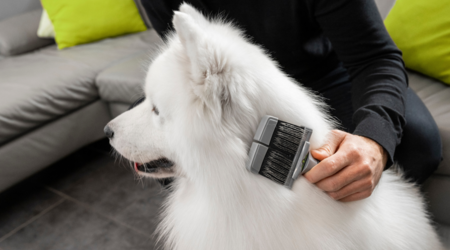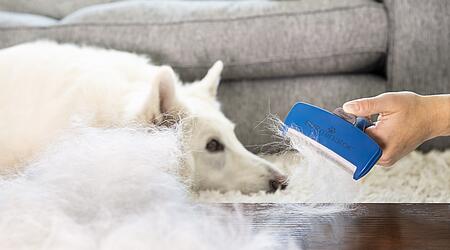Mastering the coat change:
How to guide your pet through the shedding season
Changing their coat is a completely normal process for dogs and cats that takes place twice a year. Just as we humans adapt our clothes to the seasons, our four-legged friends also change their coats to adapt to the changing temperatures. But when exactly does the change of coat take place and how can you help your pet to get through this phase as comfortably as possible?
In this article, you will learn everything you need to know about shedding in dogs and cats, including practical tips on care and support.
- Seasonal shedding explained: Dogs and cats change their coat twice a year – in spring to grow a lighter summer coat, and in fall to prepare for colder months.
- Spring shedding: Triggered by longer daylight and reduced melatonin, dogs lose their thick winter coat between April and May.
- Fall shedding: Shorter days increase melatonin, leading to the growth of a warm undercoat, while old fur is gradually replaced.
- Cats also change their coats seasonally, but indoor cats may shed all year due to stable indoor temperatures.
- Support during coat change: Regular brushing and using a deShedding tool like the FURminator® remove loose hair, reduce itching and odour, and keep your pet’s coat healthy and shiny.

When do dogs and cats change their coat?
The shedding of fur is a natural process in animals that allows them to adapt to the changing seasons. Most dogs and cats shed their thick winter coat in spring and develop a lighter summer coat. In the fall, they renew their fur again to prepare for the colder months. The "furriest" months are usually April to May and September to October but the shedding period can vary from animal to animal and can last longer or shorter.

Why do dogs shed in spring?
In spring, when the temperatures rise and the days get longer, dogs start to shed. Depending on the breed, they lose their winter coat and develop a lighter summer coat to adapt to the warmer temperatures. This process is mainly triggered by the longer daylight hours, which reduce melatonin production in the brain. This hormone not only controls the sleep-wake rhythm, but also the change of coat. Particularly in the months of April and May, this can lead to increased hair loss.
Why do dogs shed in winter?
In the fall, when the days get shorter, melatonin production increases, causing the body to develop a thicker winter coat with an additional undercoat. This extra layer protects the dog from the cold. Dogs also shed during this time, but to a lower degree than in spring. The shedding in the fall helps to replace the old coat with a new, thicker coat that provides better protection against the cold temperatures.
When do cats shed their winter coat?
Just like dogs, cats also change their coat twice a year. In spring they lose their thick winter coat and grow a lighter summer coat, while in fall the thick winter coat grows back.
However, cats that live in warm homes can also shed all year round, as the temperature differences are not as big.
Support during coat change: Shed treatment for dogs and cats
Shedding can be uncomfortable for cats and dogs, especially those with a thick undercoat, such as Labradors, Bernese Mountain Dogs, German Shepherds and Golden Retrievers. Dead hair that remains in the coat can cause itching. Regular brushing, preferably daily, removes dead hair, massages the skin and improves air circulation. This relieves itching and reduces the musty odour that can result from the decomposition of dead hair. It also helps to detect skin problems at an early stage.
Additional deShedding aims to remove loose, dead undercoat without damaging the coat when used correctly. This method reduces the amount of falling hair and ensures a healthier, shinier coat.
deShedding: How to remove loose hair effectively
A special deShedding device such as the FURminator® is particularly effective at removing dead hair from the undercoat. In contrast to normal brushing, deShedding penetrates deep into the undercoat and removes loose hair before it falls out. This not only reduces the amount of hair in the household, but also prevents matting.

Make shedding easier for your pet and yourself
With a FURminator® you can effectively remove dead hair and keep your pet's coat healthy and well-groomed.
Support your pet and order your FURminator® now!



